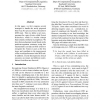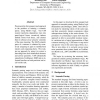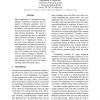EMNLP
2009
14 years 4 months ago
2009
In this paper, we first compare several strategies to handle the newly proposed three-way Recognizing Textual Entailment (RTE) task. Then we define a new measurement for a pair of...
EMNLP
2009
14 years 4 months ago
2009
Minimum error rate training (MERT) involves choosing parameter values for a machine translation (MT) system that maximize performance on a tuning set as measured by an automatic e...
EMNLP
2009
14 years 4 months ago
2009
Current methods of using lexical features in machine translation have difficulty in scaling up to realistic MT tasks due to a prohibitively large number of parameters involved. In...
EMNLP
2009
14 years 4 months ago
2009
Tree based translation models are a compelling means of integrating linguistic information into machine translation. Syntax can inform lexical selection and reordering choices and...
EMNLP
2009
14 years 4 months ago
2009
Distance-based (windowless) word assocation measures have only very recently appeared in the NLP literature and their performance compared to existing windowed or frequency-based ...
EMNLP
2009
14 years 4 months ago
2009
We present the first unsupervised approach to the problem of learning a semantic parser, using Markov logic. Our USP system transforms dependency trees into quasi-logical forms, r...
EMNLP
2009
14 years 4 months ago
2009
Many approaches to unsupervised morphology acquisition incorporate the frequency of character sequences with respect to each other to identify word stems and affixes. This typical...
EMNLP
2009
14 years 4 months ago
2009
Keyphrases are widely used as a brief summary of documents. Since manual assignment is time-consuming, various unsupervised ranking methods based on importance scores are proposed...
EMNLP
2009
14 years 4 months ago
2009
This paper investigates a new task, subjectivity word sense disambiguation (SWSD), which is to automatically determine which word instances in a corpus are being used with subject...
EMNLP
2009
14 years 4 months ago
2009
Information Extraction (IE) systems that extract role fillers for events typically look at the local context surrounding a phrase when deciding whether to extract it. Often, howev...



